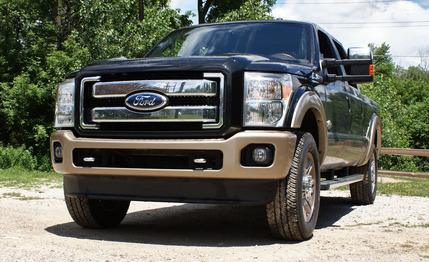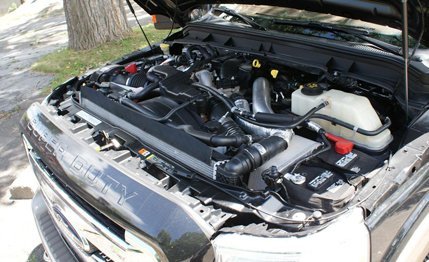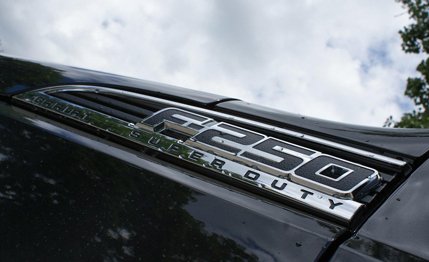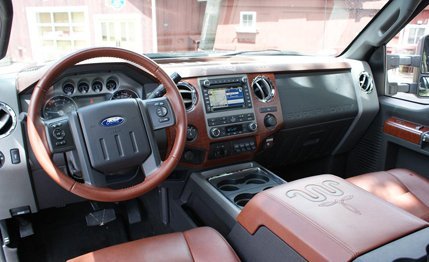 Short Take Road Test
Short Take Road Test

In the heavy-duty-truck world, manufacturers and owners live by one rule: Bigger is better. That’s how we’ve arrived at trucks with four-ton curb weights, three-ton payload capacities, and 12-ton towing capabilities. But you can’t haul that kind of mass without some serious firepower, and the diesel powertrains from GM, Ford, and Dodge have started an all-out torque war in the Motor City.
Dearborn’s newest piece of artillery in this battle is the all-new, Ford-designed and -built, 6.7-liter Power Stroke diesel V-8, available in the redesigned 2011 F-series Super Duty lineup. On a diesel kick since welcoming a Ram 2500 diesel into our long-term fleet, we were eager to see how the Power Stroke would stack up.
The New Power Stroke
Before we get into the nitty-gritty of our experience with the F-250, let’s take a closer look at that brute under its hood. After Ford’s relationship with Navistar—its previous diesel-engine supplier—went south, the blue-oval team brought the task of designing, engineering, and building the Power Stroke in-house. Ditching the old cast-iron block, engineers opted to use a new compacted graphite iron material to save weight. They also reversed the normal intake and exhaust flow by essentially flipping the aluminum heads around. Air now enters the engine on the outsides of the heads, and the exhaust manifolds are in the engine valley, joined by a single turbocharger.

The end result of the new tech was 390 hp and an asphalt-destroying 735 lb-ft of torque, but then the 2011 Chevy Silverado and GMC Sierra debuted with a new Duramax diesel that trumped the Ford with 397 hp and 765 lb-ft. Not one to lose a pissing match, Ford squeezed out another 10 hp and 65 lb-ft with a simple engine-computer reflash, for respective totals of 400 and 800.
We first tested the 2011 Super Duty prior to the reflash, setting an F-250 loose on the test track, where it put down some impressive figures. Bending the scales at a hefty 7960 pounds, the truck scooted to 60 mph in eight seconds flat, an improvement of 0.7 second over the outgoing model. It was also 0.5 second better than a gasoline F-350 we tested—which weighed about 620 fewer pounds—and 0.4 quicker than our long-term heavy-duty Ram diesel. The quarter-mile time also dropped, to 16.2 seconds at 86 mph, compared with 16.8 seconds for the old truck and 16.6 for the gas ’11 F-350. Stopping from 70 mph required 221 feet—and maybe an anchor. After just three stops from 70, the brake pedal sank to the floor.

Then we got our hands on an updated 400/800 truck and headed back to the track. The results, not surprisingly, suggest that this is primarily a marketing war, as this more-powerful truck, 120 pounds (or 1.5 percent) lighter than the first, was barely able to improve on the pre-updated truck’s acceleration times. Zero to 60 mph took 7.9 seconds, an improvement of 0.1 second, and the quarter-mile passed in 16.0, 0.2 second quicker but also at 86 mph. By 90 mph, the updated truck had a 0.5-second lead, at 17.4 seconds as opposed to 17.9.
Clocking In
When we initially got our hands on the 2011 Super Duty, we had time to put the 390-hp weakling to work. Spec Miata aboard, our trailer tipped the scales at about 4000 pounds—light work compared with the truck’s maximum tow rating of 14,000 pounds, or 15,700 with a fifth wheel. Add a few hundred pounds in the bed—tools, spare tires, and other equipment for the weekend—and the 6.7-liter was unfazed. Acceleration was strong and smooth, and the new 6R140 six-speed automatic provided far softer shifts than we have experienced in our Ram. The combo returned a stout 15 mpg overall with a healthy mix of city and highway driving, both unladen and towing.
Lexus Quiet? No, Really.
Whatever its output rating, the diesel is remarkably quiet. Hardly any clatter or turbo noise is audible, and the interior (in beautiful King Ranch spec here) is actually quieter than in the last Lexus we tested. At wide-open acceleration the Ford measures 69 decibels, five fewer than a Lexus ES350; and even cruising at 70 mph, the F-250 is a hushed 66 dBA compared with the ES350’s 69.
Visibility is excellent all around, and Ford’s split-pane mirrors—they incorporate normal and convex lenses to minimize blind spots—extend outward at the push of a button. It’s a cinch to adjust them to accommodate any trailer. Another towing boon is the steering. At 4.2 turns lock-to-lock, it’s super slow and tiresome for parking-lot maneuvers, but it keeps small oscillations of the trailer from constantly jiggling the steering wheel. There’s even a little feedback—unusual in a truck this size—but the rack feels wobbly over particularly rough surfaces as the front wheels dance around. Braking with the trailer didn’t yield the extreme fade observed during our punishing test regimen, much to our relief.

Our biggest complaint concerns the occasionally unsettling ride. Despite the (ever so slightly) lighter-duty underpinnings, this F-250 suffers from the same chassis quivers over rough terrain that we found in an F-350. It’s surprising how carlike these giants have become, but hit a rough patch, and the tremors take you back to pickups of another decade.
Adding It Up
Once you’ve paid $7835 for the diesel and almost $4800 for the King Ranch trim, there’s no avoiding a sticker price as eye-popping as the F-250’s hauling credentials. The King Ranch package nets exceptionally comfortable and supple leather chairs and two-tone paint—as well as a host of other exterior enhancements—plus remote start, heated and cooled front seats, a rearview camera that makes hitching a trailer a snap, and power-adjustable pedals. Additionally, our Super Duty was garnished with a sunroof ($995), a tailgate step ($375), a spray-in bedliner ($450), a stowable bed extender ($250), a heavy-duty alternator ($75), an engine-block heater ($75), a navigation system ($1875), auxiliary switches that we couldn’t stop flipping ($125), and the Chrome package, which coats the running boards, mirrors, tow hooks, and tailpipe in the shiny stuff ($445). All told, the bill came to a staggering $64,225, a substantial $10,000 more than our well-equipped—but far less coddling—long-term Ram.
This Ford has an excellent powertrain and an interior that would keep us comfortable all the way across the country, but $64,000 is a princely sum. Even without the King Ranch interior, this truck tops a comparably equipped Ram or Silverado by several grand. It’s one helluva hauler, but unless your “bigger is better” approach extends to sticker price as well, you can find a comparable truck for less.